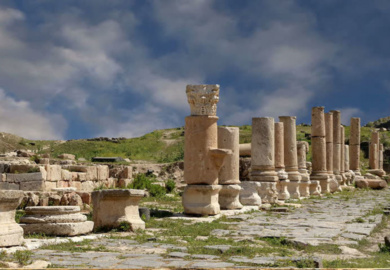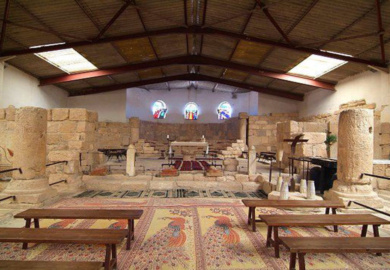Wadi Mujib
Geography
During the last ice age the water level of the Dead Sea reached 180 metres (590 ft) below sea level, about 240 metres (790 ft) higher than it is today. It flooded the lower areas of the canyons along its banks, which became bays and begun to accumulate sediments. As the climatic conditions changed, about 20,000 years ago, the water level of the lake dropped, leaving the re-emergent canyons blocked with lake marl. Most canyons managed to cut through their plugged outlets and to resume their lower courses. However, Wadi Mujib, abandoned its former outlet by breaking through a cleft in the sandstone. This narrow cleft became the bottleneck of an enormous drainage basin with a huge discharge. During the years the cleft was scoured deeper and the gorge of Wadi Mujib was formed.
The Mujib Reserve of Wadi Mujib is located in the mountainous landscape to the east of the Dead Sea, in the southern part of Jordan Valley Jordan , approximately 90 kilometres (56 mi) south of Amman. A 212-square-kilometre (82 sq mi) reserve was created in 1987 by the Royal Society for the conservation of nature and is regionally and internationally important, particularly for the bird life that the reserve supports. In 2011, UNESCO declared Mujib biosphere reserve Mujib It extends to the Kerak and madaba mountains to the north and south, reaching 900 metres (3,000 ft) above sea level in some places. This 1,300-metre (4,300 ft) variation in elevation, combined with the valley’s year round water flow from seven tributaries, means that Wadi Mujib enjoys a magnificent biodiversity that is still being explored and documented today.The reserve consists of mountainous, rocky, and sparsely vegetated desert (up to 800 metres (2,600 ft)), with cliffs and gorges cutting through plateaus. Perennial, spring-fed streams flow to the shores of the Dead Sea.
Over 300 species of plants, 10 species of carnivores and numerous species of permanent and migratory birds have been recorded until this date. Some of the remote mountain and valley areas are difficult to reach, and thus offer safe havens for rare species of cats, goats and other mountain animals.
The slopes of the mountainous land are very sparsely vegetated, with a steppe-type vegetation on plateaus. Groundwater seepage does occur in places along the Dead Sea shore, for example at the hot springs of Zara, which support a luxuriant thicket of Acacia, Tamarix,Phoenix and Nerium, and a small marsh. The less severe slopes of the reserve are used by pastoralists for the grazing of sheep and goats.
The hot springs of Hammamat Ma’in lie close to the borders of the reserve are heavily used for tourism and recreation.
The Jordanian military have a temporary camp in the south of the reserve.
The Mujib Dam was completed in 2004 at the bottom of the wadi, where the modern road crosses the river. As a result, a large lake has formed. Today, Wadi Mujib is fed by seven tributaries.
Biblical history
Wadi Mujib, the biblical Arnon stream, has always been an important boundary-line. For a time it separated the Moabites from the Amorites.
After the Hebrew settlement it divided, theoretically at least, Moab from the tribes of Reuben and Gad. But Moab, in fact, lay as much to the north as it did to the south of the Arnon. To the north, for example, were Aroer, Dibon, Medeba, and other Moabite towns. Even under Omri and Ahab, who held part of the Moabite territory, Israel did not hold sway farther south than Ataroth, about ten miles north of the Arnon.
Mesha in his inscription (Mesha Stele, line 10) says that the Gadites (not the Reubenites) formerly occupied Ataroth, whence he in turn expelled the people of Israel. He mentions (line 26) his having constructed a road along the Arnon. The ancient importance of the river and of the towns in its vicinity is attested by the numerous ruins of bridges, forts, and buildings found upon or near it. Its fords are alluded to by the Book of Isaiah. Its “heights,” crowned with the castles of chiefs, were also celebrated in verse.
Animals
As well as resident birds, the reserve is strategically important as a safe stop-over for the huge number of migratory birds which fly annually along the Great Rift Valley between Africa and northeast Europe. It is possible to see the following birds in Mujib:
Many carnivores also inhabit the various vegetation zones in Mujib, such as the striped hyena and the Syrian wolf. One of the most important animals in Mujib is the Nubian ibex, a large mountain goat which became threatened as a result of over-hunting.
Walk in water through a deep sandstone gorge of Wadi Mujib.
Experience Jordan’s most famous river canyon!
The terrain of the Wadi Mujib Reserve consists of rugged, arid mountains and flowing rivers. The deeply cut sandstone mountains of the Mujib Reserve span an elevation drop of over 1,200 meters: from 900m above sea level to 400m below – the lowest ground level on Earth. Because of this dramatic change in altitude and the presence of several flowing rivers.
Mujib is a very rough, warm area and the walk is called adventure walk because it contains swimming and hiking for long hours in addition to descending a 20 m high waterfall. They are difficult yet fun trails and one has to have the ability to swim and have no fear of water and heights. It is tough, exciting, offering a chance to swim and bathe in the cool, clear waters of the Mujib and Malaqi rivers. Participants should expect to climb rocks against water flows and jump into pools of water.
The most exciting attraction of Mujib is the adventure tour along the river: an all day trip which takes you through deep canyons and pools where you can swim and enjoy the spectacular scenery and wildlife.
Mujib is a wonderful place for nature lovers who are fit and enjoy walking. Facilities are simple and it can get very hot in summer.
The Ibex Trail : (2-3 hours) begins at the Mujib Bridge Reception by the Mujib Bridge on the Dead Sea highway, from where a guide will escort you south for a short distance along the highway before turning onto a steeply ascending trail into the nature reserve. After the first steep climb it diverges to the south, following a wide track running parallel to the Dead Sea. The Sea provides a startlingly blue backdrop throughout the hike. About one third of the distance along the trail, there is an optional detour up the mountainside to Qasr Riyash, a ruined fortification of uncertain date. Villagers say that it is one of four castles in the area, occupied by a powerful Bedouin sheikh known as Riyash. Each of his sons reputedly occupied a castle, until a fight erupted over grazing rights and all of them were killed. The climb to the castle is arduous but offers breathtaking views over the Dead Sea.
Returning to main track, the hike continues towards the Raddas Ranger Station, dipping up and down across a number of dry wadis. There are an amazing variety of rock colours and formations along the route and as you near the ranger station, the famous rock “statue” of Lots wife can be seen on the seaward edge of the reserve. It is said that while fleeing the villages of Sodom and Gomorrah, Lot’s wife ignored the warning not to look back and was turned into a pillar of salt. It takes 3 hours to get to the rangers station (4 km) At the station, there is a large fenced enclosure in which you can see a small breeding herd of magnificent Nubian Ibex– a wild ‘mountain goat’ with long, impressively curved horns. This animal was once common in the region but has been decimated by hunting. Mujib is one of the few safe havens for Ibex, in the reserve, there is a captive breeding programme to boost the wild population. In recent years, many Ibex from this enclosure have been released into the reserve to replenish the wild population that was devastated by hunting. After a rest at the station, visitors hike from the station to the entrance of the reserve through a road that takes 1.5 hours.
Mujib Biosphere Reserve
This wonderful reserve, which ranges from an altitude of 900m above sea level to 400m below, was originally established by the RSCN for the captive breeding of the Nubian ibex, but it also supports a surprising variety of over 400 species of plants (including rare orchids), 186 species of birds and 250 animal species, including the Syrian wolf, striped hyena, caracal and Blandford’s fox. It’s also an important staging post for migratory birds travelling between Africa and Europe. The reserve faces several challenges but it’s encouraging to see parties of schoolchildren here, as the future of Jordan’s ecological heritage is in their hands. The visitor centre is along the Dead Sea Highway, about 20km south of the Dead Sea resorts, beside a suspension bridge across Wadi Mujib. Guides are compulsory for all but the Siq Trail and should be booked in advance through the RSCN. Only 25 people per day are allowed on each trail and there’s a minimum group size of three on some trails. Apart from the Ibex Trail, children under 16 are not allowed. Life jackets are provided. There are three wet trails (open between 1 April and 31 October) and two dry (open year-round). The best time to visit is April and May, although February and March, and October and November are the high seasons. The region is extremely hot and dry for most of the year, so guided treks usually begin early in the morning. For the wet trails, you may be wading up to your chest in water (or swimming) so bring a swimming costume, towel, walking shoes that can get wet, and a waterproof bag for your valuables and camera. A spare set of clothes is also recommended.




Facebook Comments